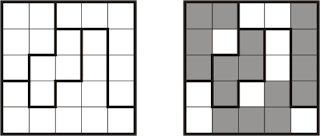Here is some solving tips for the Fifty-fifty type. I will show them through the
practise puzzle.
Tip 0:
When a hexagon contain 3 painted or 3 empty cells we can fill the remaining cells.
Tip 1:
When 2 hexagons meet (they have 2 common cells) AND one of them has 2 empty cells from the 4 non-common cells AND the other one has 2 painted then we can mark remainin non-common cells.
With these 2 tips we can make a lot of steps in the practise puzzle.
First we can use the Tip0, then we can continue the solving with Tip1.
Then we can apply the Tip 0 and Tip 1 again and again.
etc.
Tip 2:
This is the extension of Tip1. It needs 4 hexagons, on hexa in the center and 3 other which have 2 painted cells from the non-common cells. (Green area.)
In this situation we can't paint any cells in the center, but we can mark empty the remaining cells of the 3 outer hexas.
Most of the fifty puzzles contain hexagon(s) with 3 painted cells. but this isn't always true.
In this situation the Tip 2 provides starting point. For instance we can start the solving of the practise puzzle with this tip:
Conclusion:
These are the most relevant solving tips for this type. We use the tip 2 rarely but it is also important.
My suggestion that search the places where you can apply Tip 0 and Tip 1, and when there is no more try to apply Tip 2.
Good luck for everybody on the Marathon.




















































